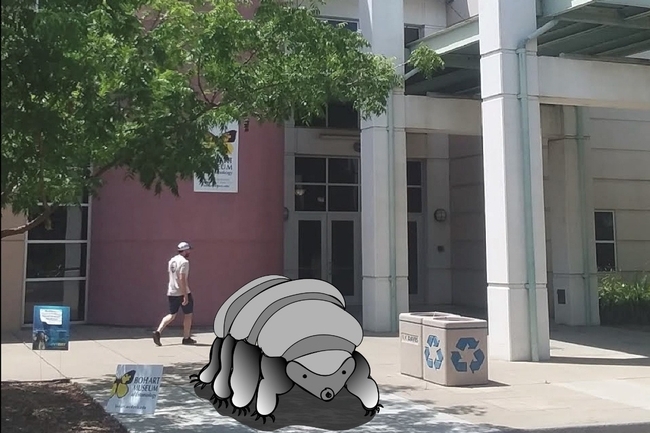
Or more specifically, think "sculpture in front of the Bohart Museum of Entomology at the University of California, Davis."
The Bohart Museum, which owns one of the world's largest tardigrade collections, plans to install a tardigrade sculpture to grace its entrance, says director Lynn Kimsey, professor of entomology at UC Davis.
The Bohart Museum Society has set up a GoFundMe account: see https://www.gofundme.com/f/waterbear-sculpture.
"The reason for this is that we have one of the world's largest tardigrade collections, which was compiled by (senior museum scientist) Steve Heydon's predecessor, Bob Schuster," Kimsey explained. "This collection is the result of years of collecting, mounting, imaging, and identifying by former collection manager Bob Schuster and emeritus professor Al Grigarick and their collaborators."
The Bohart collection includes some 25,000 slide-mounted specimens. Kimsey and collaborator Carl Johannsen work on a National Science Foundation grant to database and conserve the collection.
Kimsey says this about tardigrades:
- They belong to their own phyllum, the Tardigrada (meaning "slow steppers"), and to date there are some 1,500 described species throughout the world."
- They belong to one most peculiar and indestructible groups of animals known. Microscopic and nearly indestructible, they can survive being heated to 304 degrees Fahrenheit or being chilled for days at -328 F. And, even if they're frozen for 30 years, they can still reproduce." See video on EurekAlert.
- Tardigrades can survive high pressures of more than 1,200 atmospheres found in the bottom of the abyss. They can tolerate 1,000 times more ionizing radiation than other animals.
- In research published in 2016, geneticist Takekazu Kunieda and his colleagues from the University of Tokyo found that the water bear expresses a tardigrade-specific protein that binds itself to DNA. This acts like a "shield against x-ray radiation, preventing the DNA from snapping apart," according to an article published in Gizmodo.
- German zoologist Johann August Ephraim Goeze (1731-1793) first described the critters in 1773, referring to them as "kleiner Wasserbär," or "little water bears."
- They're easiest to find on lichens and mosses but they can also be found on beaches, in the subtidal zone, freshwater sediments, soil, hot springs and even on barnacles. They've been found high in the Himalayas to down in the deep sea. They've even been found in the interior of Antarctica.
- They mostly feed on plants or bacteria but some are predators on smaller tardigrades. They use the stylets in their tubular mouth (snout) to pierce individual plant or bacterial ells or small invertebrates.
- The stubby water bear sports a barrel-shaped body and eight pudgy legs. The adults usually range from 0.3 to 0.5 mm in length.
- They are really popular with kids in part because of their representation in the movies Ant-Man and Ant-Man and the Wasp, Star Trek and Family Guy.
Kimsey has been in touch with sculptor Solomon Bassoff (Faducciart) in Roseville. "He did the caterpillar in the Davis Central Park."
The donations are coming in.
- Alumnus and donor Stephen Clement commented: "I donated because of the mentoring I received from Al Grigarick (major professor for Ph.D) and from Bob Schuster for his taxonomic help (M.S. degree), 1970-1976."
- Donor Pablo Bleyer declared: "Tardigrades were some of my childhood friends."
- Donor Bob Goldstein: "Davis seems like a great place for a tardigrade sculpture! I'm inspired by the tardigradologists and nematologists I've admired there. A eutardigrade seems like it'd be less prone to causing injuries, but I can support a heterotardigrade :)"
"Tardigrades are awesome," Kimsey said, marveling that "They can dry out completely and then become immortal. In fact, SpaceIL may have left thousands of dried tardigrades on the moon when it crashed earlier this year."
Meanwhile, stuffed toy water bears, the scientific version of a teddy bear, are quite popular in the Bohart Museum's gift shop, which also includes insect-themed books, posters, t-shirts, jewelry, candy, and insect collecting equipment.
The museum, located in Room 1124 of the Academic Surge Building on Crocker Lane, houses nearly 8 million insect specimens, collected globally. It also maintains a live "petting zoo" featuring Madagascar hissing cockroaches, walking sticks and tarantulas.
And on the horizon: a one-of-a-kind, talk-of-the-campus tardigrade sculpture.
Attached Images:
